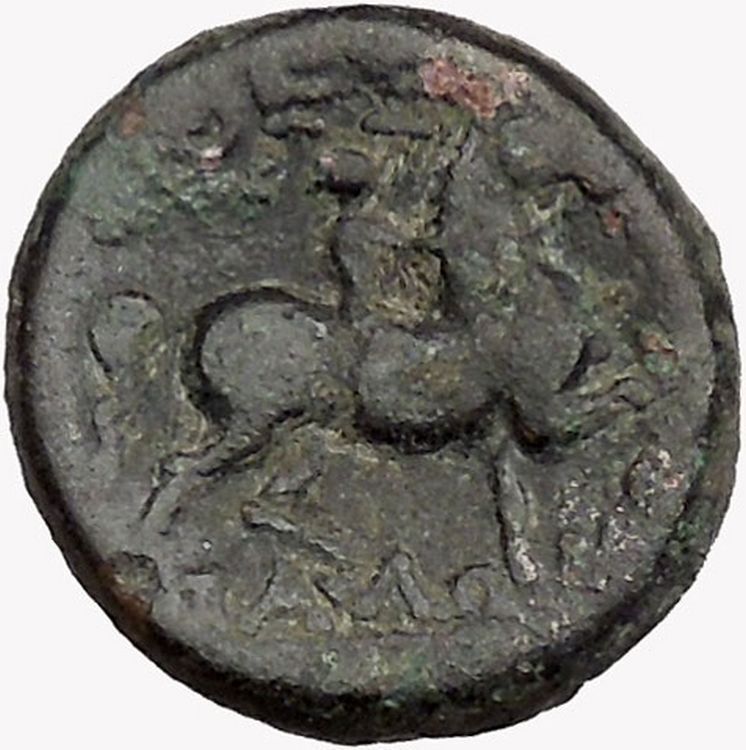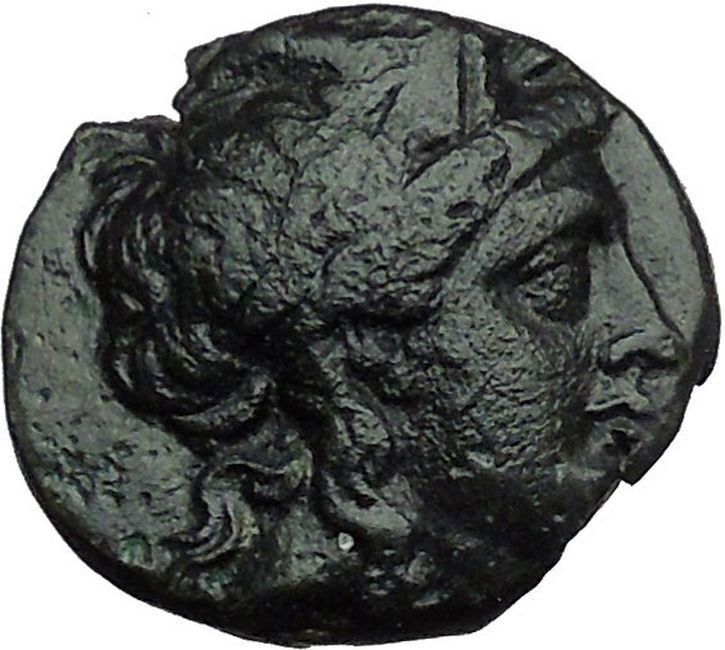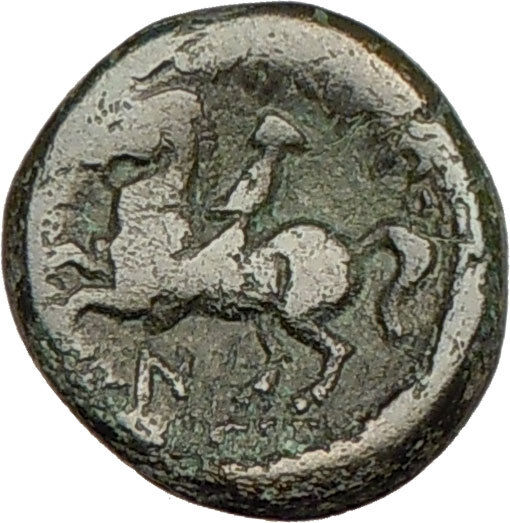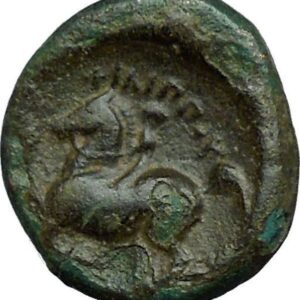|
Greek city of
Syracuse in
Sicily
Struck under Dionysios I and Dionysios II, circa 375-344 B.C.
Bronze Trias 18mm (6.76 grams)
Reference: HGC 2, 1456; Sear 1193 (Timoleon time); B.M.C. 2. 289; CNS II, nos.
34-45
ΣYPA, Head of
Athena left, wearing Corinthian helmet bound with olive-wreath.
Hippocamp left, with curled wing.
When in it’s foundations that the
city of Syracuse only consisted of the island of Ortygia, that island was said
to have been the home of the nymph Arethusa. She had been a chaste, faithful
attendant of Artemis. It is said that she got the unwanted attentions from the
river god, Alpheios, while bathing in his Peloponnesian stream. Artemis hid her
in a cloud in an attempt to save her, however she sweated so profusely out of
fear that she was transformed into a stream. Artemis broke apart the ground to
allow her to escape. She found her way to the island of Ortygia where she became
the fountain on that island.
You are bidding on the exact item pictured,
provided with a Certificate of Authenticity and Lifetime Guarantee of
Authenticity.
The hippocamp or hippocampus (plural: hippocamps or hippocampi;
Greek
: ἱππόκαμπος,
from ἵππος, “horse” and
κάμπος, “monster”), often called a
sea-horse in
English
, is a mythological creature shared by
Phoenician
and
Greek mythology
, though the name by which it is
recognised is purely Greek; it became part of
Etruscan mythology
. It has typically been
depicted as a horse in its forepart with a coiling, scaly, fishlike
hindquarter
.
Mythology

Hippocamp in Roman mosaic in the
thermae
at
Aquae Sulis
(Bath)
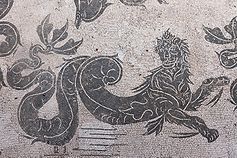
A sea-lion mosaic in the Baths of Neptune,
Ostia Antica
Homer
describes
Poseidon
, who was god of horses (Poseidon
Hippios), earthquakes, and the sea, drawn by “brazen-hoofed”
horses over the sea’s surface, and
Apollonius of Rhodes
, being consciously archaic
in Argonautica
(iv.1353ff), describes the
horse of Poseidon emerging from the sea and galloping away across the
Libyan
sands.
In
Hellenistic
and
Roman
imagery, however, Poseidon (or Roman
Neptune
) often drives a sea-chariot
drawn by hippocampi. Thus hippocamps sport with this god in both ancient
depictions and much more modern ones, such as in the waters of the 18th-century
Trevi Fountain
in Rome surveyed by Neptune from
his
niche
above. (illustration, right)
The appearance of hippocamps in both
freshwater
and
saltwater
is counter-intuitive to a modern
audience, though not to an ancient one. The Greek picture of the natural
hydrological cycle
did not take account of the
condensation of atmospheric water as rain to replenish the
water table
, but imagined the refreshening of
the waters of the sea oozing back landwards through vast underground
caverns
and
aquifers
, rising replenished and freshened in
springs.
Thus it was natural for a temple at
Helike
in the coastal plain of
Achaea
to be dedicated to Poseidon
Helikonios, (the Poseidon of Helicon), the sacred spring of
Boeotian Helikon
.
When an earthquake suddenly submerged the city, the temple’s bronze Poseidon
accompanied by hippocamps continued to snag fishermens’ nets.
Likewise, the hippocamp was considered an appropriate decoration for
mosaics
in Roman
thermae
or public baths, as at
Aquae Sulis
modern day
Bath
in Britannia (illustration, below).
Poseidon’s horses, which were included in the elaborate sculptural program of
gilt-bronze and ivory
, added by a Roman client to the temple of
Poseidon at Corinth
, are likely to have been hippocamps;
the Romanised Greek
Pausanias
described the rich ensemble in the
later 2nd century CE (Geography of Greece ii.1.7-.8):
Within the sanctuary of the god stand on the one side portrait statues of
athletes
who have won victories at the
Isthmian games
, on the other side pine
trees growing in a row, the greater number of them rising up straight. On
the temple, which is not very large, stand bronze
Tritons
. In the fore-temple are images, two
of Poseidon, a third of
Amphitrite
, and a Sea, which also is of
bronze. The offerings inside were dedicated in our time by
Herodes Atticus
, four horses, gilded except
for the hoofs, which are of ivory, and two gold
Tritons
beside the horses, with the parts
below the waist of ivory. On the car stand Amphitrite and Poseidon, and
there is the boy
Palaemon
upright upon a
dolphin
. These too are made of ivory and
gold. On the middle of the base on which the car is has been wrought a Sea
holding up the young
Aphrodite
, and on either side are the
nymphs called
Nereids
.

Hippocamp
Art Deco
fountain,
Kansas City, Missouri
,
(1937)
|
Hippocamps appear with the first Orientalising phase of
Etruscan civilization
: they remain a theme in
Etruscan tomb wall-paintings and reliefs, where they are sometimes provided with
wings, as they are in the Trevi fountain. Katharine Shepard found in the theme
an Etruscan belief in a sea-voyage to the other world.
Aside from aigikampoi, the fish-tailed
goats representing
Capricorn
or
Aegeus
(“goat-man”)
other fish-tailed animals rarely appearing in Greek art but more characteristic
of the Etruscans included leokampoi (fish-tailed
lions), taurokampoi (fish-tailed
bulls) or pardalokampoi (fish-tailed
leopards
).
The mythic hippocamp has been used as a
heraldic charge
, particularly since the
Renaissance, most often in the
armorial bearings
of people and places with
maritime associations. However, in a
blazon
, the terms hippocamp and
hippocampus now refer to the real animal called a seahorse, and the
terms seahorse and sea-horse refer to the mythological creature.
The above-mentioned fish hybrids are seen less frequently.

Athena
or Athene (Latin:
Minerva
),
also referred to as Pallas Athena, is the goddess of war, civilization,
wisdom, strength, strategy, crafts, justice and skill in
Greek mythology
.
Minerva
,
Athena’s Roman incarnation, embodies similar attributes. Athena is also a shrewd
companion of heroes
and the goddess
of heroic
endeavour. She is the
virgin
patron of Athens
.
The Athenians built the
Parthenon
on the Acropolis of her namesake city, Athens, in her honour (Athena Parthenos).
Athena’s cult as the patron of Athens seems to have existed from the earliest
times and was so persistent that archaic myths about her were recast to adapt to
cultural changes. In her role as a protector of the city (polis),
many people throughout the Greek world worshiped Athena as Athena Polias
(“Athena of the city”).
Athens
and Athena bear etymologically connected names.
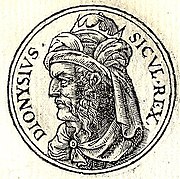
Dionysius
I or Dionysius the Elder (Greek:
Διονύσιος ὁ Πρεσβύτερος; c. 432 – 367 BC)
was a Greek
tyrant
of
Syracuse
, in what is now
Sicily
, southern Italy. He conquered several
cities in Sicily and southern Italy, opposed
Carthage
‘s influence in Sicily and made
Syracuse the most powerful of the Western
Greek
colonies. He was regarded by the ancients
as an example of the worst kind of despot—cruel, suspicious and vindictive.
Early life
Dionysius began his working life as a clerk in a public office. Because of
his achievements in the war against Carthage that had begun in 409 BC, he was
elected supreme military commander in 406 BC; in the following year he seized
total power and became tyrant. In subsequent years he consolidated his position
ruthlessly.
Mercenaries and
autocracy
Dionysius the Elder’s victory over the
democratic
Syracuse represents both the very
worst and the very best of the
mercenary
-leader. Dionysius’ career as a despot
occurred after he was given six hundred personal mercenaries to guard his person
after faking an attack on his own life. He was able to increase this guard to
one thousand and gradually consolidated his power and established himself as a
tyrant. He imposed his mercenaries on all parts of the
polis
community. Such an act would have truly
wiped out any suggestion that democracy was still in force. His rule was
“unconstitutional and illegitimate and could not fail to provoke rebellions
among the partisans of democratic government”. Dionysius’ position at home would
be threatened even as early as 403 by those philosophically opposed to tyranny.
Interestingly,
Sparta
, which had in the past
deposed
tyrants from
Corinth
to
Athens
, did not damn Dionysius and his
autocracy
. In fact relations between the two
were very positive:
When the Lacedaemonians [Spartans] had settled the affairs of Greece to
their own taste, they dispatched Aristus, one of their distinguished men, to
Syracuse, ostensibly pretending that they would overthrow the government,
but in truth with intent to increase the power of the tyranny; for they
hoped that by helping to establish the rule of Dionysius they would obtain
his ready service because of their benefactions to him.
Dionysius would even have the privilege of being allowed to conscript
mercenaries from lands under Spartan authority. The demise of a prominent
democratic polis in the
classical world
and the subsequent tenure of
Dionysius represented what would become a recurring norm in fourth century
Greece, thanks to the prevalence of mercenaries. The mercenary and the tyrant
went hand-in-hand;
Polybius
for example noted how “the security of
despots rests entirely on the loyalty and power of mercenaries”.
Aristotle
wrote how some form of ‘guard’ (viz.
a personal army) is needed for absolute kingship, and for an elected tyrant a
very particular number of professional soldiers should be employed; too few
undermines the tyrants power and too many threatens the polis itself. The
philosopher notes how based on this observation, the people of Syracuse were
warned to not let Dionysius conscript too many ‘guards’ during his reign.
Conquests
He fought a
war with Carthage
from 397 BC to 392 BC with
mixed success; his attempts to drive the Carthaginians entirely out of the
island of Sicily failed, and at his death they were masters of at least a third
of it. He also carried on an expedition against
Rhegium
, capturing it and attacking its
allied cities in
Magna Graecia
. In one campaign, in which he was
joined by the Lucanians, he devastated the territories of
Thurii
and
Croton
in an attempt to defend
Locri
.
Dionysius of Syracuse’s military attempts to place Alcetas in the
throne of the Molossians
After a protracted siege, he
took Rhegium
in 386 and sold the inhabitants as
slaves. Also he pillaged the temple of
Caere
(then allied with Rome) on the
Etruscan
coast. In the
Adriatic
, to facilitate trade, Dionysius
founded Ancona
,
Adria
and
Issa
. After him, the Adriatic became a sea of
Syracuse. In the
Peloponnesian War
, he joined the side of the
Spartans
and assisted them with
mercenaries
.
In 385 BC,
Alcetas of Epirus
was a refugee in Dionysius’
court. Dionysius wanted a friendly monarch in
Epirus
, so he sent 2,000 Greek
hoplites
and 500 suits of Greek armour to help
the Illyrians under
Bardyllis
in attacking the
Molossians
of Epirus. They ravaged the region
and killed 15,000 Molossians, and Alcetas regained his throne. He joined the
Illyrians
in an attempt to plunder the temple
of Delphi
. Sparta intervened under
Agesilaus
, however, and with aid from Thessaly,
Macedonia, and the Molossians themselves, the Spartans expelled the Illyrians.
Death
According to others, he was poisoned by his physicians at the instigation of
his son,
Dionysius the Younger
who succeeded him as
ruler of Syracuse. His life was written by
Philistus
, but the work is not extant.
Additionally, it is said that upon hearing news of his play, The Ransom of
Hector, winning the competition at the Lanaean festival at Athens, he
celebrated so fiercely that he drank himself to death. Others report that he
died of natural causes shortly after learning of his play’s victory in 367 BC.
The third theory suggests that the company, of which he was a member, had taken
revenge on his earlier purges and taxation imposed upon them, in an attempt to
raise money for the war with Carthage.
Intellectual tastes
Like
Pisistratus
, tyrant of
Athens
, Dionysius was fond of having literary
men about him, such as the historian
Philistus
, the poet
Philoxenus
, and the philosopher
Plato
, but treated them in a most arbitrary
manner.
Diodorus Siculus
relates in his
Bibliotheca historica
that Dionysius once
had Philoxenus arrested and sent to the quarries for voicing a bad opinion about
his poetry. The next day, he released Philoxenus because of his friends’
requests, and brought the poet before him for another poetry reading. Dionysius
read his own work and the audience applauded. When he asked Philoxenus how he
liked it, the poet turned to the guards and said “take me back to the quarries.”
Plutarch
relates a version of this story in his
On the Fortune of Alexander.
He also posed as an author and patron of literature; his poems, severely
criticized by
Philoxenus
, were hissed at the Olympic games;
but having gained a prize for a tragedy on the Ransom of Hector at the
Lenaea
at
Athens
, he was so elated that he engaged in a
debauch which proved fatal.
His name is also known for the legend of
Damon and Pythias
, and he features indirectly
(via his son) in the legend of the Sword of
Damocles
. The
Ear of Dionysius
in Syracuse is an artificial
limestone cave named after Dionysius.
Walls of Syracuse
In 402 BC Dionysius I began building the Circuit Walls of Syracuse. They were
completed in 397 BC and had the following characteristics:
- Length: 27 kilometers
- Width at base: 3.3 m to 5.35 m
- Number of known towers on circuit: 14 (including Euryalos)
- Largest tower: 8.5 m x 8.5 m
- Deepest ditch (at Euryalos fortress): 9 m
Building so big a fortress would have involved installing well over 300 tons
of stone every day for 5 years.
Fictional references
Dionysius I is mentioned in
Dante
‘s
Inferno
(of the
Divine Comedy
) (1308–21) as a tyrant who
indulged in blood and rapine and suffers in a river of boiling blood. A
fictional version of Dionysius is a character in
Mary Renault
‘s historical novel
The Mask of Apollo
(1966). He also features
prominently in
L. Sprague de Camp
‘s
historical novel
The Arrows of Hercules
(1965) as a patron
of inventors on the island of
Ortygia
near Syracuse. He is the main character
in
Valerio Massimo Manfredi
‘s novel Tyrant
(2003). He is also featured in the 1962 film
Damon and Pythias
.

Dionysius
the Younger or Dionysius II (c. 397 BC – 343 BC) ruled
Syracuse
,
Sicily
from 367 BC to 357 BC and again from 346
BC to 344 BC.
He was the son of
Dionysius the Elder
. When his father died in
367 BC, Dionysius began ruling under the supervision of his uncle, the
philosopher
Dion
. Dion’s disapproval of the young
Dionysius’s lavishly dissolute lifestyle compelled him to invite his teacher
Plato
to visit Syracuse. Together they
attempted to restructure the government to be more moderate, with Dionysius as
the archetypal philosopher-king (see the
Seventh Letter
of
Plato
).
However, under the influence of opponents of Dion’s reforms, Dionysius
conspired with the historian
Philistus
and banished his uncle, taking
complete power in 366 BC. Without Dion, Dionysius’s rule became increasingly
unpopular, as he was mostly incompetent in governing men and commanding
soldiers. When Plato appealed for Dion’s return, the irritated Dionysius
interfered with Dion’s property and finances and gave his wife to another man.
Before this, Dion’s Syracusan estates had financed his peaceful and comfortable
life overseas in Athens
, but Dionysius’s last offence spurred
him into action.
Dion formed a small army at
Zacynthus
and returned to Sicily in 357 BC,
much to the delight of the Syracusans. As Dionysius was in
Caulonia
,
Italy
at the time, Dion easily took all but
Syracuse’s island citadel. Dionysius sailed back to Syracuse immediately, and
upon his return he attempted attacks from the citadel and tried to negotiate
peace treaties. When he was unsuccessful in all attempts, he sailed away to
Locri
, Italy and left the citadel in the hands
of his son
Apollocrates
.
In exile, Dionysius took advantage of the friendly citizens of Locri and
became the city’s tyrant, treating the locals with great cruelty. He did not
return to Syracuse until 346 BC, eight years after Dion’s assassination by his
officers. Soon after he left Locri, the locals drove out the remaining troops
and took their revenge on Dionysius’s wife and daughters. Dionysius was able to
regain power in Syracuse only because of its great political instability, as he
was still very unpopular among the Syracusans. In the preceding several years,
many other cities on Sicily had split from Syracuse and were ruled by local
tyrants. Several of these cities joined the Syracusans in an attack against
Dionysius which proved to be quite successful, and Dionysius was forced back
into the citadel. At this time, 344 BC,
Timoleon
arrived and began his invasion of
Sicily. Dionysius, out of respect for Timoleon and quite aware he no longer had
a chance of victory, arranged the surrender of the citadel and was given safe
passage to Corinth
,
Greece
. For the next year until his death,
Dionysius lived privately in Corinth in an increasingly miserable state.
In popular
culture and literature
Dionysius is one of the central characters in the legend of the
Sword of Damocles
.
Dionysius also appears in
Dante’s Inferno
, in which he is referred to as
“Dionysius of Sicily” in Canto 12. He is among the many souls named by Chiron
that boil in blood for violence against others.
Michael Maier
the renaissance alchemist relates
a legend about Dionysius II in his book, the Atalanta Fugiens (1617), that he
actually got shipwrecked at the
Gulf of Corinth
, and without his swimming
skills he could have never reached the shore. At Corinth, although he lived
poorly, he became a teacher. Maier uses this legend as an allegory to explain a
certain point in the
Magnum opus
, when the “philosophical subject”
(the stone) must ascend to the surface of the “philosophical water”.
Notes
Maier, Michael (1617). Atalanta Fugiens.
trans. Peter Branwin. Johann Theodor de Bry. chapter 31.
References
- This article incorporates text from a publication now in the
public domain
: Wood,
James, ed. (1907). “article name needed“.
The Nuttall Encyclopædia
. London and
New York: Frederick Warne.
Preceded by:
Dionysius the Elder
|
Tyrant of Syracuse
367 BC – 356 BC |
Succeeded by:
Dion
|
Preceded by:
Nysaeos
|
Tyrant of Syracuse
347 BC – 344 BC |
Succeeded by:
Timoleon
|
Syracuse pronounced,
Sicilian
: Sarausa, is a historic
city in
southern Italy
, the
capital
of the
province of Syracuse
. The city is famous for its rich Greek history,
culture
,
amphitheatres
,
architecture
and association to
Archimedes
,
playing an important role in ancient times as one of the top powers of the
Mediterranean
world; it is over 2,700 years old. Syracuse is located in the
south-east corner of the island of
Sicily
, right
by the Gulf of Syracuse next to the
Ionian Sea
.
The city was founded by
Ancient Greek
Corinthians
and became a very powerful
city-state
.
Syracuse was allied with
Sparta
and
Corinth
,
exerting influence over the entire
Magna Grecia
area of which it was the most important city. Once
described by Cicero
as “the greatest Greek city and the most beautiful of them all”, it later became
part of the
Roman Republic
and
Byzantine Empire
. After this
Palermo
overtook it in importance, as the capital of the
Kingdom of Sicily
. Eventually the kingdom would be united with the
Kingdom of Naples
to form the
Two Sicilies
until the
Italian unification
of 1860.
In the modern day, the city is listed by
UNESCO
as a
World Heritage Site
along with the
Necropolis of Pantalica
. In the central area, the city itself has a
population of around 125,000 people. The inhabitants are known as Siracusans,
and the local language spoken by its inhabitants is the
Sicilian language
. Syracuse is mentioned in the
Bible
in the
Acts of the Apostles
book at 28:12 as
Paul
stayed there.
The patron saint
of the city is
Saint Lucy
;
she was born in Syracuse and her feast day,
Saint Lucy’s Day
, is celebrated on 13 December.
Greek period
Syracuse and its surrounding area have been inhabited since ancient times, as
shown by the findings in the villages of Stentinello, Ognina, Plemmirio,
Matrensa, Cozzo Pantano and Thapsos, which already had a relationship
with
Mycenaean Greece
.
Syracuse was founded in 734 or 733 BC by Greek settlers from
Corinth
and Tenea
,
led by the oecist (colonizer)
Archias
, who called it Sirako, referring to a nearby salt marsh. The
nucleus of the ancient city was the small island of Ortygia. The settlers
found the land fertile and the native tribes to be reasonably well-disposed to
their presence. The city grew and prospered, and for some time stood as the most
powerful Greek city anywhere in the
Mediterranean
. Colonies were founded at
Akrai
(664 BC),
Kasmenai
(643 BC),
Akrillai
(VII century BC), Helorus
(VII century BC) and
Kamarina
(598 BC). The descendants of the first colonist, called Gamoroi, held the
power until they were expelled by the Killichiroi, the lower class of the
city. The former, however, returned to power in 485 BC, thanks to the help of
Gelo, ruler of
Gela. Gelo himself
became the despot of the city, and moved many inhabitants of Gela, Kamarina and
Megera to Syracuse, building the new quarters of
Tyche
and
Neapolis
outside the walls. His program of new constructions included a new
theater, designed by
Damocopos
, which gave the city a flourishing cultural life: this in turn
attracted personalities as
Aeschylus
,
Ario of
Metimma
, Eumelos of
Corinth
and
Sappho
, who had
been exiled here from
Mytilene
.
The enlarged power of Syracuse made unavoidable the clash against the
Carthaginians
, who ruled western Sicily. In the
Battle of Himera
, Gelo, who had allied with Theron of
Agrigento
,
decisively defeated the African force led by
Hamilcar
. A
temple
,
entitled to Athena
(on the site of the today’s Cathedral), was erected in the city to commemorate
the event
Gelon was succedeed by his brother
Hiero
, who
fought
against the
Etruscans
at Cumae
in 474 BC. His rule was eulogized by poets like
Simonides of Ceos
,
Bacchylides
and Pindar
, who visited his court. A democratic regime was introduced by
Thrasybulos
(467 BC). The city continued to expand in
Sicily
,
fighting against the rebellious
Siculi
, and on the
Tyrrhenian Sea
, making expeditions up to
Corsica
and
Elba. In the late
5th century BC, Syracuse found itself at war with
Athens
, which
sought more resources to fight the
Peloponnesian War
. The Syracusans enlisted the aid of a general from
Sparta
, Athens’
foe in the war, to defeat the Athenians, destroy their ships, and leave them to
starve on the island (see
Sicilian Expedition
). In 401 BC, Syracuse contributed a force of 3,000
hoplites
and a general to
Cyrus the Younger
‘s
Army of the Ten Thousand
.
Then in the early 4th century BC, the
tyrant
Dionysius the Elder
was again at war against
Carthage
and, although losing Gela and Camarina, kept that power from capturing the whole
of Sicily. After the end of the conflict Dionysius built a massive fortress on
the Ortygia
island of the city and 22 km-long walls around all of Syracuse. Another period
of expansion saw the destruction of
Naxos
, Catania
and Lentini
, then Syracuse entered again in war against Carthage (397 BC). After
various changes of fortune, the Carthaginians managed to besiege Syracuse
itself, but were eventually pushed back by a pestilence. A treaty in 392 BC
allowed Syracuse to enlarge further its possessions, founding the cities of
Adrano, Ancona
,
Adria
, Tindari
and Tauromenos, and conquering
Reggio Calabria
on the continent. Apart from his battle deeds, Dionysius was
famous as a patron of art, and
Plato
himself
visited Syracuse several times.
His successor was
Dionysius the Younger
, who was however expelled by
Dion
in 356 BC. But the latter’s despotic rule led in turn to his expulsion,
and Dionysius reclaimed his throne in 347 BC. A democratic government was
installed by Timoleon
in 345 BC. The long series of internal struggles had weakened
Syracuse’s power on the island, and Timoleon tried to remedy this, defeating the
Carthaginians in 339 BC near the
Krimisos
river. But the struggle among the city’s parties restarted after
his death and ended with the rise of another tyrant,
Agathocles
,
who seized power with a coup in 317 BC. He resumed the war against Carthage,
with alternate fortunes. He however scored a moral success, bringing the war to
the Carthaginians’ native African soil, inflicting heavy losses to the enemy.
The war ended with another treaty of peace which did not prevent the
Carthaginians interfering in the politics of Syracuse after the death of
Agathocles (289 BC). The citizens called
Pyrrhus of Epirus
for help. After a brief period under the rule of Epirus,
Hiero II
seized power in 275 BC.
Hiero inaugurated a period of 50 years of peace and prosperity, in which
Syracause became one of the most renowned capitals of Antiquity. He issued the
so-called Lex Hieronica, which was later adopted by the Romans for their
administration of Sicily; he also had the theater enlarged and a new immense
altar
, the “Hiero’s
Ara”, built. Under his rule lived the most famous Syracusan, the
natural philosopher
Archimedes
.
Among his many inventions were various military engines including the
claw of Archimedes
, later used to resist the
Roman
siege of 214 BC–212 BC. Literary figures included
Theocritus
and others.
Hiero’s successor, the young
Hieronymus
(ruled from 215 BC), broke the alliance with the Romans after
their defeat at the
Battle of Cannae
and accepted
Carthage
‘s
support. The Romans, led by consul
Marcus Claudius Marcellus
,
besieged the city
in 214 BC. The city held out for three years, but fell in
212 BC. It is believed to have fallen due to a peace party opening a small door
in the wall to negotiate a peace, but the Romans charged through the door and
took the city, killing Archimedes in the process.
From
Roman domination to the Middle Ages
Though declining slowly by the years, Syracuse maintained the status of
capital of the Roman government of Sicily and seat of the
praetor
. It
remained an important port for the trades between the Eastern and the Western
parts of the Empire.
Christianity
spread in the city through the efforts of
Paul of Tarsus
and Saint Marziano, the first bishop of the city, who made it
one of the main centres of
proselytism
in the West. In the age of the persecutions massive
catacombs
were carved, whose size is second only to those of Rome.
After a period of
Vandal
rule, Syracuse and the island was recovered by
Belisarius
for the
Byzantine Empire
(31 December 535). From 663 to 668 Syracuse was the seat of
Emperor Constans II
, as well as metropolis of the whole Sicilian Church.
Another siege in 878, resulted in the city coming under two centuries of
Muslim
rule. The
capital was moved from Syracuse to
Palermo
. The
Cathedral was converted into a
mosque
and the
quarter on the Ortygia island was gradually rebuilt along Islamic styles. The
city, nevertheless, maintained important trade relationships, and housed a
relatively flourishing cultural and artistic life: several Arab poets, including
Ibn Hamdis
,
the most important Sicilian poet of the 12th century, flourished in the city.
In 1038, the Byzantine general
George Maniaces
reconquered the city, sending the relics of St. Lucy to
Constantinople
. The eponymous castle on the cape of Ortygia bears his name,
although it was built under the
Hohenstaufen
rule. In 1085 the
Normans
entered Syracuse, one of the last
Arab
strongholds, after a summer-long siege by
Roger I of Sicily
and his son
Jordan of Hauteville
, who was given the city as count. New quarters were
built, and the cathedral was restored, as well as other churches.
In 1194
Henry VI
of Swabia
occupied Syracuse. After a short period of
Genoese
rule (1205–1220), which favoured a rise of trades, Syracuse was
conquered back by emperor
Frederick II
. He began the construction of the
Castello Maniace
, the Bishops’ Palace and the Bellomo Palace. Frederick’s
death brought a period of unrest and feudal anarchy. In the struggle between the
Anjou
and
Aragonese
monarchies, Syracuse sided with the Aragonese and defeated the
Anjou in 1298, receiving from the Spanish sovereigns great privileges in reward.
The pre-eminence of baronal families is also shown by the construction of the
palaces of Abela
,
Chiaramonte
, Nava
,
Montalto
.
|













